Osteoarthritis the shoulder joint is a pathology, which affects the bone and cartilaginous structure. The first stages of the disease proceed without pronounced clinical signs. Progressive pathological changes lead to serious consequences. Treatment and diagnostics of 1, 2, 3 or 4 degrees is dealt with by a rheumatologist.
Record content:
- 1 General description of the disease
- 2 Reasons for development
- 3 Symptoms
- 4 Stages
- 5 Diagnosis
-
6 Treatment methods
- 6.1 Drug treatment
- 6.2 ethnoscience
- 6.3 Physiotherapy
- 6.4 Manual therapy
- 7 Diet
- 8 Physiotherapy
- 9 Possible complications of the disease
- 10 Shoulder arthrosis video
General description of the disease
Osteoarthritis of the shoulder joint is a disease characterized by degenerative-dystrophic processes that affect joints and cartilage tissue. Pathology is more common in people over 45 years old.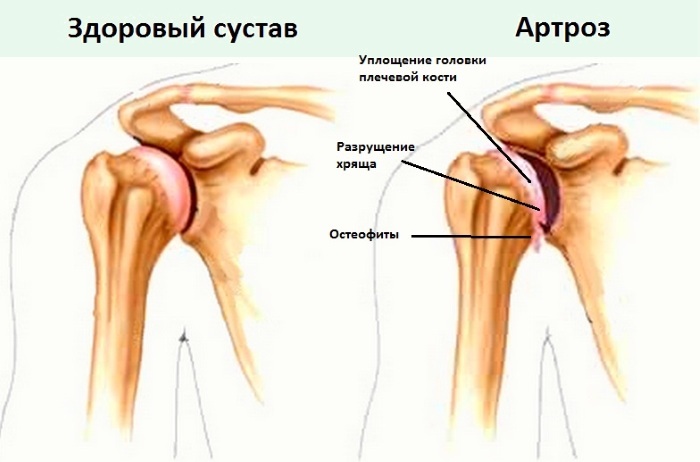
In most cases, degenerative-dystrophic processes affect large joints in the human body. The main common cause is a lot of physical activity. The disease causes discomfort and disrupts the usual way of life, reducing performance.
Reasons for development
There are numerous provoking factors against which osteoarthritis of the shoulder joint develops:
- constant mechanical and physical stress on the shoulders;
- professional activity, when a person has to perform monotonous movements (miners, builders, surgeons, bakers);
- certain sports activities (wrestling, boxing, volleyball, gymnastics);
- injuries and injuries of the shoulder (dislocation, fracture, sprain, rupture of ligaments, tendons);
- infectious or viral damage to the body;
- congenital skeletal anomalies;
- hypothermia of the body;
- concomitant diseases of the musculoskeletal system;
- elderly age.
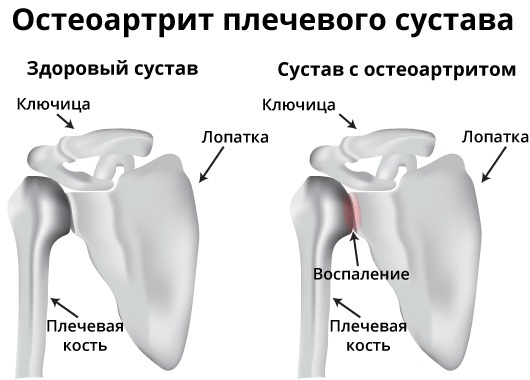
Shoulder osteoarthritis is a degenerative form of arthritis
Extra pounds, a hereditary factor, diseases of the joints and bones can also provoke the development of osteoarthritis of the shoulder joint. The same applies to surgery, endocrine and hormonal disorders in the human body.
Symptoms
The clinical picture of brachial osteoarthritis will allow the rheumatologist to determine the area of the lesion by pathological processes and select the most effective therapy regimen.
Osteoarthritis of the shoulder joint of 1-4 degrees (treatment is selected by a specialist after a comprehensive diagnosis) is accompanied by the following symptoms:
- regular pain syndrome in the shoulder and neck area that occurs at rest or after exertion;
- fatigue after doing the simplest things;
- stiffness of movements;
- pain spreads throughout the arm;
- during movement of the affected limb, a characteristic sound (crunch) is heard.
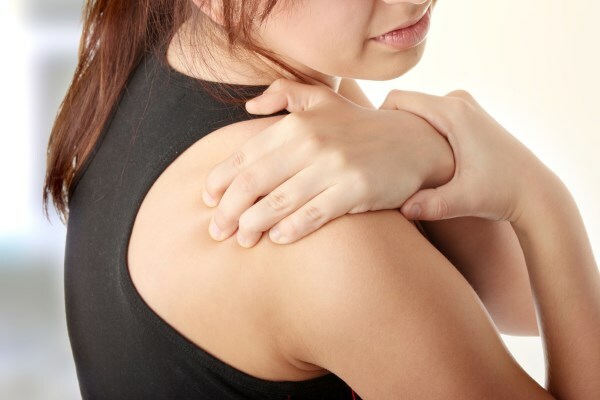
Clinical signs will increase with the progression of pathological processes. Therefore, it is important to go to the hospital when the first symptoms appear.
Stages
Degenerative-dystrophic processes in osteoarthritis proceed in stages. At each stage, certain clinical signs appear that will help the doctor determine the severity of the pathology.
Stages of shoulder osteoarthritis:
- I degree. Minor changes can be diagnosed with X-rays or magnetic resonance imaging. Pain syndrome of a person worries only after physical exertion. In some situations, there is a feeling of constriction.
- II degree of osteoarthritis. The joint space narrows, the first osteophytes are formed. The pain syndrome is present at rest, intensifies after load on the shoulder. Joint mobility deteriorates, it is difficult to lift loads. Sometimes the affected limb involuntarily relaxes.
- III degree. The clinical signs are worse. Pain in the arm is constant and pronounced, which does not allow performing the simplest movements. Mobility decreases, stiffness appears. While moving the hand, clicks are heard, which indicate bone growths. At stage 3, the bone tissue is severely destroyed, as a result of which mobility is limited, and severe pain is disturbing.
-
IV degree. The joint gap is completely closed, the epiphyses are deformed, and seals appear. The affected joint swells, the patient complains of severe pain and lack of mobility. At the 4th stage of brachial osteoarthritis, the exposed bone surfaces grow together. There is a deformation of the shoulder and a complete loss of its functionality.
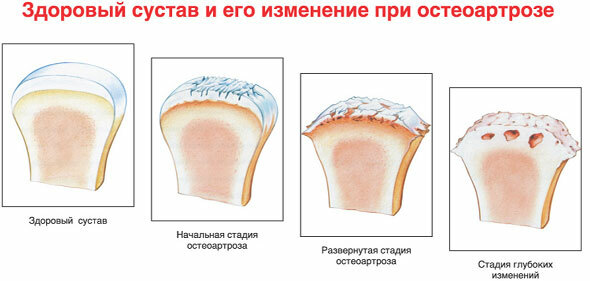
Osteoarthritis of the shoulder joint 1,2,3 degrees
Osteoarthritis of the shoulder joint cannot be ignored, since progressive degenerative-dystrophic processes will lead to serious complications. It is important to go to the hospital in a timely manner, undergo an examination and start treatment.
Diagnosis
A rheumatologist will help diagnose osteoarthritis of the shoulder joint. The specialist will conduct an examination and prescribe an additional examination. Based on the results obtained, the doctor will select an effective treatment.
Osteoarthritis of the shoulder joint 1, 2, 3, 4 degrees (treatment is carried out after a full examination) will help diagnose the following methods:
| Name | Description |
| X-ray | An examination method with which it is possible to identify a degenerative-dystrophic focus, growths, narrowing of the joint space and other pathological deformities in the joint area. |
| Magnetic resonance imaging (MRI) | The most informative examination method that will allow you to determine the area of joint damage. |
| Arthroscopy | A minimally invasive surgical method that is used for treatment and diagnosis. Arthroscopy will allow you to visually determine degenerative-dystrophic processes in the shoulder joint. |
| Ultrasound examination (ultrasound) | Ultrasonic waves help to identify pathological changes. The doctor examines the affected joint and determines the location of the inflammatory focus. |
| General blood analysis | The test results will confirm the development of the inflammatory process in the human body. |

In addition, the patient may be assigned a consultation with other specialized specialists, taking into account the severity of the disease (surgeon, orthopedist, arthrologist). It is important to differentiate osteoarthritis of the shoulder joint, since many pathological changes are accompanied by similar clinical symptoms.
Treatment methods
Treatment of osteoarthritis of the shoulder joint of 1, 2, 3 or 4 degrees is selected by a rheumatologist, taking into account the results of comprehensive diagnostics, the person's condition and the severity of the disease. It is important to strictly adhere to the drawn up scheme in order to prevent the development of complications.
Patients are prescribed special drugs, it is recommended to attend physiotherapy procedures, to adhere to a rational and healthy diet. In the absence of serious contraindications, you can be treated with folk remedies.
Drug treatment
Medicines are selected by the doctor, taking into account the individual moments associated with the patient and his condition. It is necessary to carefully read the instructions for using the drug or strictly adhere to the prescriptions of a rheumatologist. Many medications have side effects.
To combat osteoarthritis of the shoulder joint, the following remedies are used: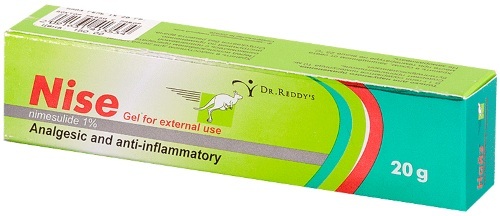
| Drug group | Name | Application |
| Non-steroidal anti-inflammatory drugs | Nise, Ketorol | Medicines reduce inflammation. Adults are prescribed orally 1 tablet 2 times a day after meals. |
| Local treatment | Voltaren, Indomethacin | Ointments and creams help to eliminate mild discomfort. The gel is applied 3-4 times a day to the damaged area of the body, rubbing in with light massage movements. A single dosage is 2 g. The course of therapy lasts 14 days. |
| Analgesics | Analgin, Paracetamol | The drugs eliminate pain syndrome. The adult recommended dosage is 1 tablet 3-4 times a day. The time interval between doses should not be less than 4 hours. The course of treatment lasts 3-5 days. |
| Corticosteroids | Diprospan, Depo-medrol | Joint injections stop the progression of degenerative-dystrophic processes. The recommended dosage for an adult is 1-2 ml. |
| Vasodilator drugs | Cinnarizin, Agapurin | The drugs improve blood circulation in the affected area of the shoulder joint. The medicine is recommended to be taken after meals by mouth, 25 mg 3 times a day. |
| Chondroprotectors | Chondroxide, Dona | Medicines stimulate the regeneration process and help restore cartilage tissue. Adults are advised to take 2 tablets 2 times a day. The duration of the course of treatment is 6 months. |
| Muscle relaxants | Sirdalud, Midocalm | Means reduce muscle spasm. The adult dosage is 2-4 mg 3 times a day. The course of therapy lasts 7 days. |
| Vitamins | Kombilipen, Milgamma, | The drugs improve tissue nutrition and the transmission of nerve impulses. The medicine is taken after meals with plenty of water. Adults are prescribed orally 1 tablet 1-3 times a day. The course of treatment is 4 weeks. |
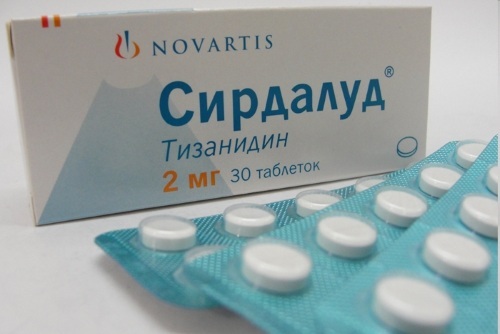
Acute painful sensations are eliminated with the help of intramuscular injections. If the articular membrane is affected by the inflammatory process, the doctor selects antibacterial drugs, taking into account the causative agents of the disease.
ethnoscience
Osteoarthritis of the shoulder joint 1, 2 degrees (treatment is carried out by complex methods under supervision of a rheumatologist) requires a thorough examination and correctly selected therapeutic agents.
Prescriptions from healers and healers help reduce the symptoms of a pathological condition, but their use should be discussed with your doctor. We must not forget about the high probability of an allergic reaction and individual sensitivity.
Effective recipes for osteoarthritis of the shoulder joint:
| Name | Recipe | Application |
| Elecampane tincture | Pour 100 g of plant root with alcohol (200 ml). Leave for 2 weeks and strain. | The resulting tincture is rubbed every day into the affected joint 2 times. The course of treatment lasts 1.5 months. |
| Nettle | Pour boiling water over dry grass (200 g) and leave for 60 minutes. | It is recommended to add the finished broth to warm water and take a bath. Carry out water procedures for 10-15 minutes. |
| Home ointment | Melt pork fat (50 g) in a water bath. Add 3 g of propolis. Heat the resulting mixture until the components are completely dissolved. Cool the finished ointment, pour into a glass container and store in a cool place. | The tool should be used for shoulder osteoarthritis 2 times a day. Rub into the affected joint. |
| Oatmeal | Pour 30 g of oatmeal with hot water (400 ml). Put the resulting mixture on medium heat and cook for another 10 minutes. Cool the product and use for a compress. | Put the finished oatmeal in a warm form on a napkin and apply to the affected joint. Wrap with plastic wrap and wrap with warm material. Leave the compress for 30-40 minutes. |
| Herbal collection | Mix 3 tbsp. l. buckthorn bark and 2 tsp. l. dandelion root. Add 2 tsp. l. parsley seeds and 3 tsp. l. peppermint leaves. Pour the herbal mixture with hot water (500 ml) and leave overnight in a dark place. Strain the finished medicine and take it orally. | Herbal decoction is recommended to be consumed before breakfast for 2 tbsp. l. |
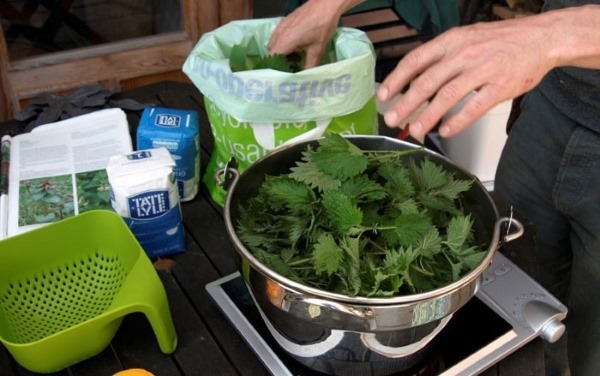
Broths based on lingonberry or young oat hay are used for compresses. Shilajit will help reduce pain and muscle spasm.
Physiotherapy
When the acute period of osteoarthritis of the shoulder joint has passed, the patient is advised to attend physiotherapy procedures. Complex treatment helps to reduce inflammation and pain syndrome, to alleviate the general condition of the patient.
| Name | Description |
| Medicinal electrophoresis | Under the influence of constant currents, the active components of the drug penetrate directly into the inflammatory focus. |
| Shockwave therapy | A method of treatment that provides for an extracorporeal short-term effect on the affected tissues with acoustic pulses of low-frequency amplitude. |
| Ozone therapy | During the treatment, ozone gas is used, which has a positive effect on the entire human body. |
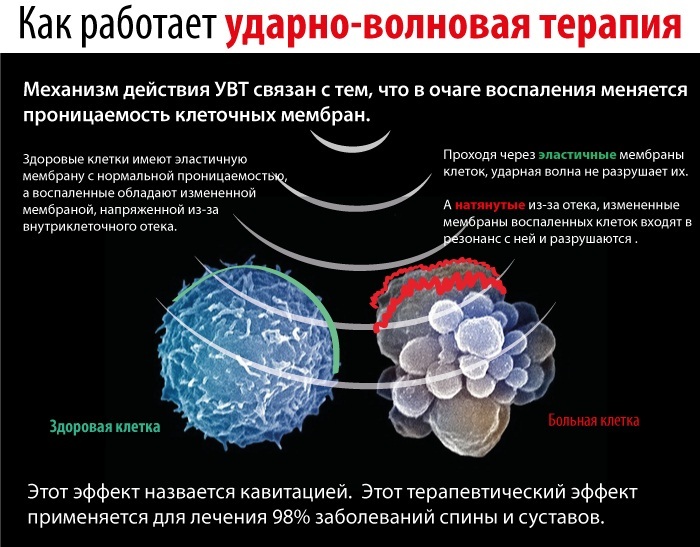
Physiotherapy restores metabolic processes in the affected area of the shoulder, strengthens the immune system and improves blood circulation.
Manual therapy
Osteoarthritis of the shoulder joint of 1-4 degrees (treatment is carried out comprehensively under the supervision of a rheumatologist) cannot be ignored. Manual therapy is prescribed to patients if there is no pain syndrome, also after the exacerbation period subsides.
The therapeutic technique provides for deep palpation, impact on the muscles by kneading, rubbing, stroking and vibrating movements. Manual therapy has a positive effect on the skeletal muscles of the shoulder girdle, strengthening it. Not only blood circulation improves, but also the mobility of the joint.
Diet
Complex therapy of osteoarthritis of the shoulder joint involves adherence to a specially selected diet. A correctly composed menu will allow you to replenish the reserves of vitamins and minerals, restore metabolic processes, and, if necessary, get rid of extra pounds. They also contribute to the development of shoulder osteoarthritis.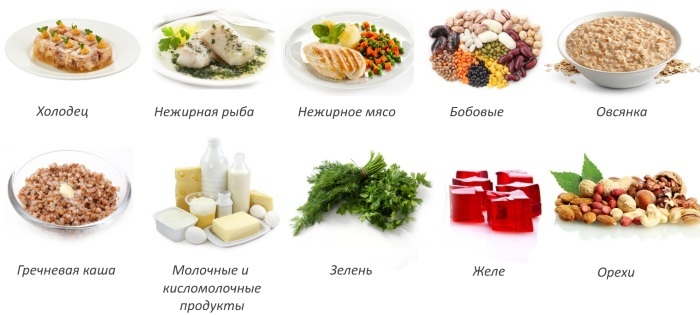
| Featured Products | Unwanted foods |
|
|
It is necessary to reduce the consumption of table salt. Eat small meals and often, control bowel movements, and avoid overeating.
Physiotherapy
An auxiliary method of treating osteoarthritis of the shoulder joint is medical gymnastics. Exercise helps to restore movement and function of the shoulder, improve blood circulation, and increase muscle tone. The complex of classes is selected by a physiotherapist, taking into account the state of the person and the degree of development of pathological processes.
Exercises for osteoarthritis of the shoulder joint:
- Standing upright, spread your feet shoulder-width apart. Bend your right arm at the elbow so that the hand lies on the right shoulder blade. Use your left hand to apply pressure to the elbow. In this case, the brush should not come off the shoulder blade. Move slowly. Returning to the starting position, change hands. Perform the exercise 4 times.
- In a standing position, stretch your arms forward. Bend each one in turn, reaching for the opposite shoulder. At the same time, apply pressure on the elbow with your free hand, without lifting the hand from the shoulder.
- Standing, put your hands behind your back and clasp into the lock. Stretch them for 10-15 seconds. in different directions, trying to disengage the lock. Relax and repeat the exercise 5-10 times.

Healing gymnastics should be performed slowly and without excessive exertion. If painful sensations appear, it is necessary to stop classes and consult a doctor.
Possible complications of the disease
In the absence of timely and correctly selected therapy, degenerative-dystrophic processes will progress.
The patient's condition deteriorates, resulting in serious complications:
| Name | Description |
| Bone necrosis | A pathological condition characterized by necrotic processes in bone tissue without the participation of pathogenic bacteria. |
| Secondary reactive synovitis | A disease in which inflammatory and degenerative processes affect the synovial membrane of the joint. The pathological condition causes an increase in body temperature and an increase in painful sensations. |
| Aseptic necrosis | The disease occurs as a result of persistent impaired blood circulation and is characterized by the decay of cartilaginous, also bone tissue. |
A complication of osteoarthritis of the shoulder joint is also deformation of the articular surfaces, impaired functioning of the bone joints. The same applies to fusion and ossification of the articular surfaces.
A person is waiting for disability and decreased performance. Progressive degenerative-dystrophic processes will not even allow themselves to be serviced without outside help.
Osteoarthritis of the shoulder joint is a serious disease that cannot be treated, especially grade 3 and 4. It is better to think in advance about your health and to prevent the development of pathological processes than to deal with them.
Correctly selected timely therapy is necessary to eliminate the discomfort and unpleasant symptoms that accompany the disease. Ignoring the pathology will lead to sad consequences.
Shoulder arthrosis video
Deforming arthrosis of the shoulder joints:



